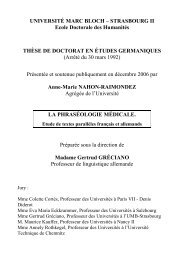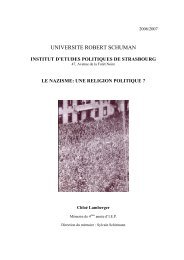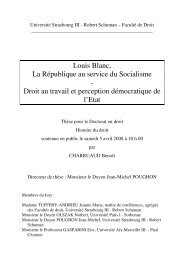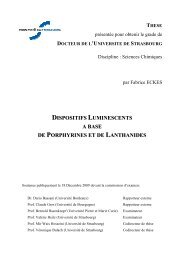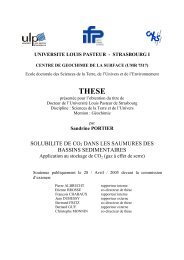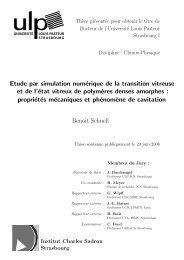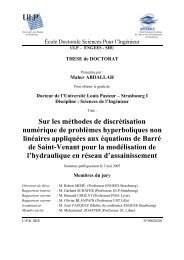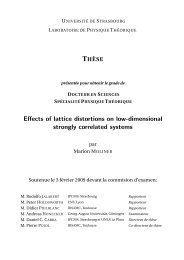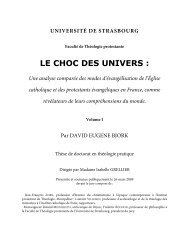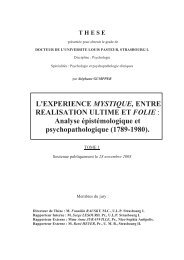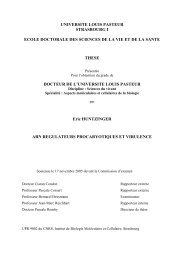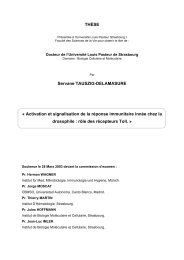Anthony KERMAGORET - THESES ET MEMOIRES DE L'UDS
Anthony KERMAGORET - THESES ET MEMOIRES DE L'UDS
Anthony KERMAGORET - THESES ET MEMOIRES DE L'UDS
You also want an ePaper? Increase the reach of your titles
YUMPU automatically turns print PDFs into web optimized ePapers that Google loves.
Scheme 2. Representation of the square-pyramidal coordination geometries<br />
around the metals in 18, 24 and 25<br />
Cl<br />
Cl<br />
Ni<br />
N<br />
Cl<br />
P<br />
Ni<br />
Cl<br />
N<br />
N<br />
Cl<br />
Ni<br />
P Cl<br />
18 24<br />
P<br />
P<br />
Cl<br />
Ni<br />
Cl<br />
N<br />
P<br />
Cl<br />
Ni<br />
N<br />
Cl<br />
25<br />
N<br />
Cl<br />
Ni<br />
Cl<br />
P<br />
Chapitre IV<br />
It is interesting to compare the structure of 18 with those of the distorted square-pyramidal<br />
dinuclear Ni(II) complexes 24 and 25 which contain five- and seven-membered ring P,N<br />
chelates. 42,50<br />
N<br />
P<br />
Ph 2<br />
Ni<br />
Cl<br />
Cl<br />
Cl<br />
24<br />
Cl<br />
Ni<br />
Ph 2<br />
P<br />
N<br />
O<br />
Ph 2P Ni<br />
In contrast to 18, complexes 24 and 25 have centrosymmetric structures and their square<br />
bases contained the atoms P, N and the 2 bridging chlorides Cl(1) and Cl(1a) (Scheme 2).<br />
The larger N-Ni-P coordination angle (96.18(9)°, Table 1) of 18 compared to 24 (84.48(9)°)<br />
or 25 (85.37(5)°) leads to the apical position being occupied by the phosphorus donor atom<br />
instead of a chloride ligand. The Ni-P and Ni-N distances in 18, of 2.305(1) and 2.061(3) Å,<br />
respectively, are similar to those in the dinuclear complexes 24 and 25 but are longer than in<br />
related mononuclear Ni(II) complexes. 50<br />
Complex 22 has a mononuclear structure with a distorted tetrahedral geometry similar<br />
to that of complex 26, in contrast to the square-planar geometry of complexes 27 and 28<br />
(Figure 3). 50 The Ni-P and Ni-N distances of 22, 2.304(1) and 2.006(3) Å (Table 2), are<br />
significantly longer than in complexes 26-28. The large Cl-Ni-Cl angle (123.47(5)°) and the<br />
small N-Ni-P angle (92.1(1)°, Table 2) result in complex 22 adopting a distorted tetrahedral<br />
geometry instead of a square-planar geometry. The steric properties of the tert-butyl<br />
substituents on phosphorus probably explain the tetrahedral coordination in 22. Tetrahedral<br />
Ni(II) complexes coordinated by phosphinopyridine 43,44 or phosphinoimine ligands 30 have<br />
N<br />
Cl<br />
Cl<br />
Cl<br />
25<br />
Cl<br />
Ni<br />
N<br />
PPh 2<br />
O<br />
10



